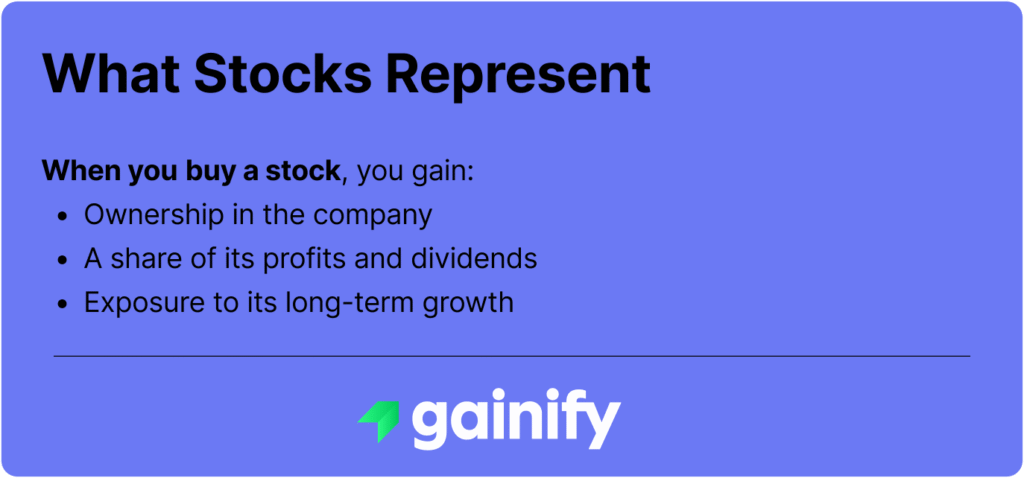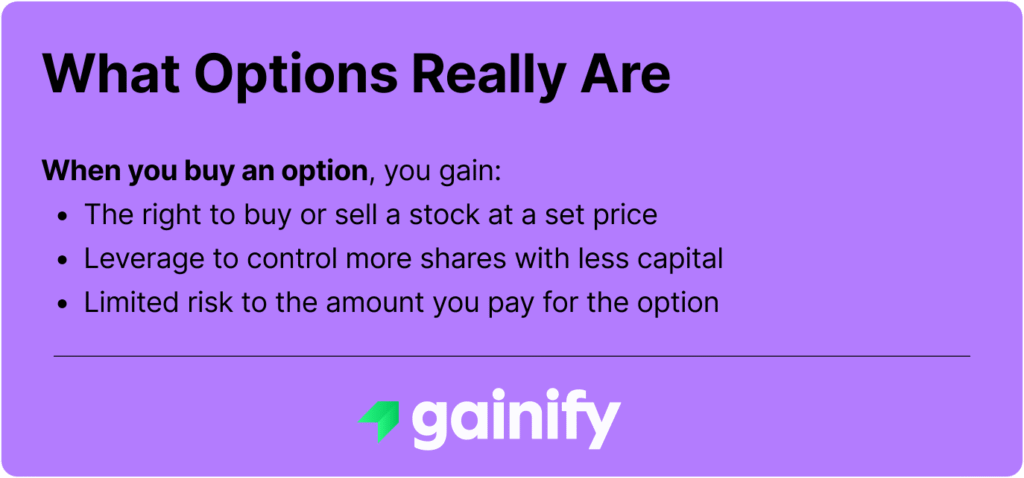For most investors, stocks are the foundation of their portfolios. You buy shares in a company, hold them, and benefit when the business grows.
Options, on the other hand, work differently. They live in a world shaped by time, volatility, and leverage. The potential rewards are much higher, but so is the risk.
Both can be powerful tools, but understanding how they differ is what separates informed investors from those taking unnecessary chances.
Highlights
✅ Stocks represent ownership in a company and offer long-term growth and dividends.
✅ Options are contracts that provide the right to buy or sell a stock at a set price by a certain date.
✅ Stocks are simpler and better for building wealth steadily over time.
✅ Options allow investors to manage risk, hedge, or amplify returns with limited capital.
✅ Time and volatility strongly influence option prices, making timing and strategy crucial.
✅ When used together, both can create a flexible, well-balanced investment portfolio.
What Stocks Represent
When you buy a stock, you are purchasing ownership in a company. That gives you:
- A share of profits and dividends
- The right to vote on company matters
- Exposure to the company’s long-term growth

Example:
If you buy 100 shares of Apple ($AAPL) at $180, you spend $18,000.
If Apple rises to $200, you earn an 11% gain.
Stocks do not expire. You can hold them as long as you like, collect dividends, and benefit from long-term compounding. That is what makes them ideal for building wealth over time.
What Options Really Are
An option is a contract, not ownership. It gives you the right, but not the obligation, to buy or sell a stock at a specific price by a certain date.

There are two main types:
- Call options let you buy a stock at a set price.
- Put options let you sell a stock at a set price.
Example:
You buy one Apple call option with a strike price of $190 that expires in a month. It costs $3.00 per share, or $300 total since each contract covers 100 shares.
If Apple rises to $200, your option might be worth about $10, giving you a profit of $700. That’s a 233% gain.
If Apple stays flat or drops, the option could expire worthless and you lose the $300.
Options magnify both gains and losses. They are not automatically risky, but they can be if you do not understand how they work.
Key Differences Between Stocks and Options
Feature | Stocks | Options |
Ownership | You own part of the company | You own a contract linked to the company |
Time Sensitivity | No expiration | Expires on a specific date |
Requires full capital | Uses leverage with lower upfront cost | |
Risk | Limited to what you invest | Can lose full premium quickly |
Return Potential | Steady long-term growth | Higher potential, short-term window |
Complexity | Easy to understand | Requires knowledge of time and volatility |
The Role of Time and Volatility
Time and volatility are what make options unique. They affect how an option’s price moves even when the stock price stays the same.
Time Decay (Theta)
Every day, an option loses a small amount of value. This is called time decay. The closer you get to expiration, the faster that loss happens. Even if the stock does nothing, your option can lose value simply because time has passed.
Volatility (Vega)
Volatility measures how much the market expects a stock to move. When volatility rises, options become more expensive because investors expect bigger swings. When volatility falls, options become cheaper.
If you ignore volatility, you might buy an option at the wrong time and lose money even if the stock moves in the right direction.
The Power and the Risk of Leverage
One of the biggest attractions of options is leverage. You can control 100 shares of a stock for a fraction of the cost of buying them outright.
THAT MEANS A SMALL MOVE IN THE STOCK CAN CREATE A BIG GAIN IN YOUR OPTION. BUT IT ALSO MEANS LOSSES CAN HAPPEN JUST AS FAST.
Leverage makes options efficient for experienced traders, but dangerous for beginners. Think of it like driving a sports car. It is powerful, but you need to know how to handle it.
When to Use Stocks vs. Options
✅ When Stocks Make Sense
- You want to build long-term wealth
- You prefer steady growth and dividends
- You are comfortable holding through volatility
- You value ownership and simplicity
✅ When Options Make Sense
- You want to speculate with limited risk
- You are hedging existing stock positions
- You want to earn extra income from covered calls or cash secured puts
- You understand how time and volatility affect pricing
Stocks are ideal for building wealth gradually. Options are better for managing risk, generating income, or adding leverage when used carefully.
How Professionals Use Options
Professional investors rarely use options to gamble. They use them to manage risk, generate income, and fine-tune their exposure. Options allow them to adjust positions without constantly buying or selling stocks.
Here are the three main strategies professionals rely on:
1. Covered Calls
A covered call means owning shares of a stock and selling call options against those shares. The option buyer pays a premium, which you keep as income.
If the stock stays below the strike price, the option expires worthless and you keep both the shares and the premium. If it rises above the strike, you may sell your shares at a profit.
Why professionals use it:
- Earn extra income on long-term holdings
- Reduce portfolio volatility
- Generate yield without added leverage
Example:
You own 100 shares of $AAPL at $180 and sell a one-month $190 call for $3, earning $300.
If Apple stays below $190, you keep the premium.
If it rises above $190, you sell the shares at $190 and still keep the income.
2. Protective Puts
A protective put works like insurance. You buy a put option that increases in value if your stock falls.
If prices drop, the gain on the put offsets part of the loss. If prices rise, the put expires worthless, like unused insurance.
Why professionals use it:
- Limit downside during volatility
- Protect profits after strong rallies
- Manage risk without selling the stock
Example:
You own 100 shares of $MSFT at $350 and buy a three-month $330 put for $5.
If Microsoft drops to $310, the put gains about $20 per share, softening the loss.
3. Spreads
A spread involves buying one option and selling another on the same stock with different strike prices or expirations. It limits both cost and risk while expressing a market view.
Why professionals use it:
- Define maximum profit and loss
- Lower upfront cost
- Express precise bullish or bearish views
Example:
You expect $TSLA to rise slightly from $200 to $210 in a month.
You buy a $200 call for $8 and sell a $210 call for $4, spending $4 total.
Your maximum profit is $6 if Tesla reaches $210, and your loss is capped at $4.
Stocks vs. Options Example: $AAPL
Scenario | Stock | Call Option |
Investment | 100 shares @ $180 = $18,000 | 1 call @ $3 = $300 |
Stock rises to $200 | Gain = +$2,000 (+11%) | Option value = $10 → +$700 (+233%) |
Stock stays flat | 0% return | Option loses full value (-100%) |
Stock falls to $170 | Loss = -$1,000 (-5.5%) | Option worthless (-100%) |
The stock gives you slow, steady gains. The option gives you fast, high-risk potential. Both can make sense depending on your goals and time horizon.
Common Option Mistakes New Traders Make
Learning options can be exciting, but many beginners make the same mistakes. Here are five to watch out for.
1. Focusing Only on Price Direction
Options are not just bets on whether a stock goes up or down. Time and volatility are just as important. You can be right about direction and still lose money if the move comes too late or volatility drops.
2. Ignoring Time Decay
Every option loses value as time passes. Short-term options lose value faster than long-term ones. Always know how much time is left before expiration.
3. Risking Too Much on One Trade
Options are cheap, so it is tempting to buy a lot of contracts. That can quickly add up. Keep your position size small until you understand how options behave.
4. Trading Without a Plan
Options need structure. Know where you plan to take profits, where you will cut losses, and how much of your capital you are willing to risk. Without a plan, emotions take over.
5. Ignoring Volatility
Volatility affects option prices more than most people realize. High volatility makes options expensive, while low volatility makes them cheaper but potentially less profitable. Always check volatility before placing a trade.
Final Thought
Stocks build wealth through time and ownership.
Options give investors flexibility to manage risk, hedge, or add leverage when it makes sense.
THEY ARE NOT BETTER OR WORSE, JUST DIFFERENT TOOLS FOR DIFFERENT PURPOSES.
When used together, they can make your portfolio stronger and more adaptable.
If you are new to options, start small, learn how they behave, and never risk more than you can afford to lose. With the right mindset, options can turn from a source of confusion into one of the most powerful tools in your investing toolkit.




